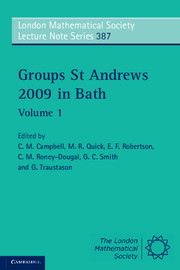Book contents
- Frontmatter
- Contents
- Introduction
- A speech in honour of John Cannon and Derek Holt
- Finite groups of Lie type and their representations
- Iterated monodromy groups
- Engel elements in groups
- Some classes of finite semigroups with kite-like egg-boxes of D-classes
- Structure of finite groups having few conjugacy class sizes
- Group theory in cryptography
- A survey of recent results in groups and orderings: word problems, embeddings and amalgamations
- A survey on the minimum genus and maximum order problems for bordered Klein surfaces
- On one-relator quotients of the modular group
- Miscellaneous results on supersolvable groups
- Automorphisms of products of finite groups
- A rational property of the irreducible characters of a finite group
- Automotives
- On n-abelian groups and their generalizations
- Computing with matrix groups over infinite fields
- Trends in infinite dimensional linear groups
- Engel conditions on orderable groups and in combinatorial problems (a survey)
- References
On n-abelian groups and their generalizations
Published online by Cambridge University Press: 05 July 2011
- Frontmatter
- Contents
- Introduction
- A speech in honour of John Cannon and Derek Holt
- Finite groups of Lie type and their representations
- Iterated monodromy groups
- Engel elements in groups
- Some classes of finite semigroups with kite-like egg-boxes of D-classes
- Structure of finite groups having few conjugacy class sizes
- Group theory in cryptography
- A survey of recent results in groups and orderings: word problems, embeddings and amalgamations
- A survey on the minimum genus and maximum order problems for bordered Klein surfaces
- On one-relator quotients of the modular group
- Miscellaneous results on supersolvable groups
- Automorphisms of products of finite groups
- A rational property of the irreducible characters of a finite group
- Automotives
- On n-abelian groups and their generalizations
- Computing with matrix groups over infinite fields
- Trends in infinite dimensional linear groups
- Engel conditions on orderable groups and in combinatorial problems (a survey)
- References
Summary
Abstract
For any integer n ≠ 0, 1, a group G is said to be n-abelian if it satisfies the identity (xy)n = xnyn. More generally, G is called an Alperin group if it is n-abelian for some n ≠ 0, 1. We consider two natural ways to generalize the concept of n-abelian group: the former leads to define n-soluble and n-nilpotent groups, the latter to define n-Levi and n-Bell groups. The main goal of this paper is to present classes of generalized n-abelian groups and to point out connections among them. Besides, Section 5 contains unpublished combinatorial characterizations for Bell groups and for Alperin groups. Finally, in Section 6 we mention results of arithmetic nature.
Keywords:n-abelian groups, Alperin groups, Bell groups, infinite subsets.
Introduction
Let n ≠ 0, 1 be an integer and let G be a group. In [4], R. Baer introduced the n-centre Z(G, n) of G as the set of all elements x ∈ G which n-commute with every element in the group, i.e. (xy)n = xnyn and (yx)n = ynxn for any y ∈ G. Later, in [20], L.-C. Kappe and M. L. Newell proved that (xy)n = xnyn for any y ∈ G if and only if (yx)n = ynxn for any y ∈ G. Thus one only n-commutative condition suffices to define Z(G, n). The n-centre is a characteristic subgroup and shares many properties with the centre (see, for instance, [4] and [20]).
- Type
- Chapter
- Information
- Groups St Andrews 2009 in Bath , pp. 244 - 255Publisher: Cambridge University PressPrint publication year: 2011



